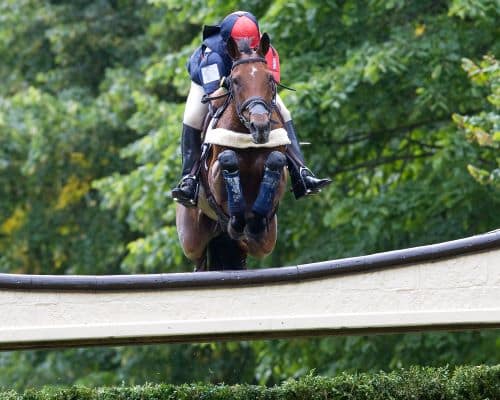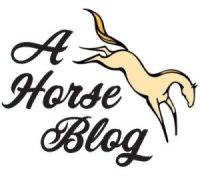Last Updated on May 11, 2024 by Teri Rehkopf

Introduction to Cross-Country Equestrian Events
Cross-country equestrian events aka Eventing stand out for their exhilarating blend of speed, endurance, and skill. These events demand a great deal from both horse and rider, drawing on their joint ability to navigate outdoor courses across varying terrain.
In cross-country riding, you will find that the joy comes from facing the expansive outdoors with your horse, testing your limits together. It’s you and your equine partner against the elements: terrain, obstacles, and the clock.
Cross-country, aka three-day eventing or horse trials, comprises three disciplines: Dressage, cross-country jumping, and show jumping. The competition may be run as a one-day event (ODE), where all three events are completed in one day (dressage, followed by show jumping and then the cross-country phase), or a three-day event (3DE), which is more commonly now run over four days, with dressage on the first two days, followed by cross-country the next day and then show jumping in reverse order on the final day.
Eventing was previously known as Combined Training, and the name persists in many smaller organizations. “Combined Training” is sometimes confused with the term “Combined Test,” which refers to a combination of just two phases, most commonly dressage and show jumping.
Eventing is an equestrian triathlon in that it combines three different disciplines in one competition, which is held over one, two, or three days, depending on the length of the courses and the number of entries.
To succeed in this sport, it’s crucial to understand its demands. You’re not just riding; you’re harnessing the bonds of trust and communication with your horse to safely complete a course that can include water jumps, ditches, and banks.
Success in this discipline doesn’t happen overnight. It takes comprehensive preparation, covering everything from physical training to equipment checks. That first ribbon or sense of accomplishment at the finish line begins with meticulous groundwork long before the day of the event.
Physical and Mental Preparation for Horse and Rider
When preparing for cross-country equestrian events, the horse and the rider’s physical and mental readiness are equally critical. Success hinges on their synergy, so a dual focus on preparing both athletes is essential.
Strong, consistent fitness training is the foundation. This includes varied terrain work for the horse, which builds muscles and stimulates mental engagement. For riders, this might mean cardiovascular activities and strength training that targets the muscles used most during riding.

Mental conditioning cannot be overlooked. It involves creating rigorous but realistic training scenarios to simulate the pressures of an event. It’s about incrementally stretching your comfort zone while maintaining a sharp focus under diverse conditions.
Thanks for the image, Elisa Pitkanen of Unsplash.
Nutrition plays a vital role, too. Balancing a diet that fuels muscle growth and sustains energy levels throughout grueling cross-country events is as important as physical training. Always consult a veterinarian or a nutritionist specialized in equestrian athletes for a diet that supports your horse’s training regimen.
Remember, physical and mental preparation cannot be achieved overnight. It requires planning, consistency, and patience. Now, I will walk you through specific training techniques that can help you perfect that crucial horse-rider communication and improve your agility on the course.
Training Techniques and Course Familiarization
Success in cross-country equestrian events doesn’t happen overnight. It results from consistent training and a deep understanding of the course you’ll be riding. I recommend starting with a strategic training schedule. Months in advance, work with your coach to develop a calendar that progressively builds your horse’s stamina and skills. These sessions should include flatwork, jumping exercises, and conditioning gallops to mimic competition demands.
Communication is the linchpin between you and your horse. Incorporate exercises that enhance responsiveness and dexterity into your training to refine this. Pole work and gridwork can be particularly effective for teaching horses to be agile and attentive to your cues. Also, don’t forget to include hack sessions in different terrains to help you and your horse adapt to varying conditions.
Course walks play a pivotal role in familiarizing yourself with the challenges ahead. Never skip these. It’s your chance to plan your ride, identify tricky combinations, and decide where to push for speed or take a steadier approach. Taking notes and pictures can help you revisit specific obstacles and strategize well before you saddle up.

Thanks to Elisa Pitkanen of Unsplash.
Switch your focus to gear as you wrap up training and start thinking about the event. In the next section, I’ll guide you through compiling a critical equipment checklist. I’ll also show you how to maintain your gear to ensure safety and performance and adapt to the unpredictable elements of cross-country riding.
Equipment Checklist and Gear Maintenance
The right equipment can make all the difference in a cross-country equestrian event. Not only does it enhance performance, but it’s also crucial for the safety of both horse and rider. I’ll walk you through the essentials and how to keep them in top condition.
You need a well-fitting saddle designed for cross-country use. This ensures your horse’s comfort and stability, especially over varied terrain. Look for one with a secure seat that offers good grip and support.
Don’t forget about the bridle and bit. Precision in communication is critical when you’re navigating obstacles at speed. Choose a bit that your horse responds well to and a bridle that fits perfectly to prevent any distractions.
Safety vests are a must for riders, and a proper fit is non-negotiable for effective protection. Add a sturdy pair of riding boots and gloves for a firm hold on the reins, plus a certified helmet that will protect your head should anything go awry.
Regular checks are essential when discussing your gear’s maintenance.
- Before every ride, inspect your tack for signs of wear or damage.
- Look for cracks in the leather, make sure buckles and clips are in working order, and check the stitching on all your gear.
- You should thoroughly clean your gear before each competition. This will help you identify any weaknesses that need to be addressed.
- Saddle pads should be cleaned frequently to avoid skin irritations on your horse.
- Boots and bandages for your horse’s legs need close attention, too; they should be free of dirt and debris to maintain support and prevent sores.
As you think about course conditions, remember that weather can affect equipment. Wet, muddy courses might warrant different care for your gear post-event, like thorough cleaning and drying to prevent mildew.
With equipment sorted, you’re ready to approach the challenges ahead. Adaptive thinking is paramount as you turn attention to the next section—readying yourself for weather and course nuances that often come into play during cross-country events.
Tailoring Your Strategy to Weather and Course Conditions
Anticipating the impact of weather and terrain is crucial in cross-country equestrian events. A sunny day can turn your ride into a smooth gallop across firm ground. Yet, the same course can become a slippery challenge after a downpour. Ensure that your strategy remains flexible. This means checking weather updates critically and adjusting my pace and tactics to align with the day’s conditions.
Just as chess players anticipate their opponents’ moves, riders must foresee the demands of different terrains. Understanding the course’s nuances allows you to leverage your horse’s strengths, whether a steep incline or a water jump.
Walk the course beforehand, noting critical areas where you need to conserve energy and spots where you can safely make up time.
Strategies need backup plans. Always prepare for the unexpected, such as equipment malfunctions or your horse becoming unusually fatigued. Carrying extra gear or having a secondary pacing plan isn’t pessimism—it’s pragmatic preparation.
With foresight and readiness, you will find yourself less daunted when facing the unpredictability of cross-country events. Understanding that adaptation is the name of the game, head into each competition confident in you and your horse’s ability to handle adversity.
Preparing for cross-country equestrian events is a test of planning, partnership, and persistence. The bond between horse and rider honed through careful preparation and mutual trust, shines brightest when tested against these events’ diverse challenges. Regardless of the outcome, each competition is a learning experience, yielding lessons that refine skills and deepen relationships.
Success in this sport isn’t measured by speed or placement; it’s about harmony in each jump and resilience in each stride. So, remember to adapt, predict, and, most importantly, enjoy the unique journey of a cross-country equestrian event.
People Also Ask
Do I need a special kind of horse for cross-country events?
- Special Kind of Horse: While any horse can potentially participate in cross-country events, certain breeds are more commonly seen due to their athleticism, endurance, and agility. Horses bred for eventing or those with a background in disciplines like show jumping or fox hunting tend to excel. Characteristics to look for include bravery, agility, stamina, and a good gallop. However, with proper training and conditioning, many horses can learn to navigate cross-country courses effectively.
How often should I train each week leading up to the event?
- Training Frequency: Training frequency depends on various factors, including the horse’s current fitness level, experience, and the event level you’re preparing for. Generally, a mix of schooling sessions, fitness work, and practice over cross-country-style obstacles is essential. Aim for a balanced training regimen spread throughout the week, including flatwork, jumping, and hacking out. Most riders aim for at least 4-6 weekly training sessions leading up to an event, adjusting intensity and duration based on the horse’s response and fitness goals.
What are common mistakes to avoid during a cross-country ride?
- Common Mistakes to Avoid:
- Overriding or micromanaging: Trust your horse’s ability to navigate obstacles and avoid interfering excessively with their stride.
- Poor pace management: Maintain a consistent and appropriate pace throughout the course to conserve your horse’s energy and avoid unnecessary faults.
- Ignoring course familiarity: Walk the course beforehand to understand the terrain, fence placements, and potential challenges.
- Neglecting fitness: Ensure your horse is adequately conditioned for the demands of cross-country, including galloping over varied terrain and jumping efforts.
- Missing proper warm-up: Warm up your horse adequately before starting the course to loosen muscles and establish focus.
- Forgetting safety gear: Always wear appropriate safety equipment, including helmets and protective vests, to minimize the risk of injury during falls or refusals.
- Lack of communication: Maintain clear communication with your horse through consistent aids and supportive cues, especially when approaching obstacles.
Have you participated in cross-country events? Do you have any bits of wisdom to share with us about eventing? Please leave me a comment below if you like this article, want to discuss the subject, or need more information.
